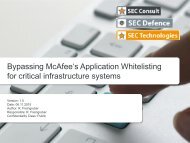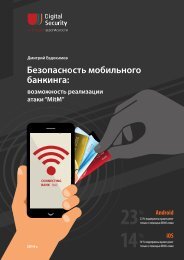1401-Baywatch
1401-Baywatch
1401-Baywatch
You also want an ePaper? Increase the reach of your titles
YUMPU automatically turns print PDFs into web optimized ePapers that Google loves.
J. Poort et al. / Telecommunications Policy ] (]]]]) ]]]–]]] 5<br />
3.1. Sample and response<br />
Both surveys were conducted in the CentERpanel, a representative online household panel. In contrast to most<br />
commercial panels, CentERpanel is not an access panel: households can only participate on invitation. The CentERpanel<br />
recruits participants with the argument that they support scientific and societal research without commercial purposes.<br />
Household selection is done through random sampling from Dutch address registers (probability sample), households<br />
without internet access receive necessary devices and support from CentERdata. As such the panel is highly representative<br />
on both observed and unobserved characteristics. 2 The panel aims to keep participants attached on a permanent basis (since<br />
1990), but some panel attrition renders periodic panel recruitment necessary. In fact, recruitments occurred between both<br />
survey measurements, during which a wave of new participants were recruited and inactive members were dropped.<br />
A total of 2009 people fully completed the first questionnaire, yielding a response rate of 64.4% (3118 members had been<br />
invited). The second questionnaire revealed a response of 2422, a response rate of 78.4%. 1692 panel members (54.3% of the<br />
first sample) participated in both surveys. The measurements are treated as two independent cross-sections in order to keep<br />
the information of one-time participants. The first sample consists of 55% men, 38% have a college degree, 40% live in a<br />
highly urbanised area. For the second sample the percentages are 53% men, 41% with a college degree, and 38% live in a<br />
highly urbanised area. As file sharing differs strongly among age groups and young age groups are somewhat underrepresented,<br />
all data were weighted by age on seven different age groups.<br />
3.2. Results<br />
3.2.1. Market developments<br />
The first measurement reveals that 27.8% of Dutch consumers purchased music in a physical format (CD, LP) in the<br />
preceding six months (Table 1). For 63.1% buying physical music formats was longer than six months ago, whereas 9.1%<br />
never did so. Overall, 51.7% obtained music from a legal source in the preceding half year: In a physical format (27.8%), as<br />
paid download or streaming (14.2%), and/or as free download or streaming from a legal source (33.2%). Finally, 18.3%<br />
downloaded music from an illegal source such as TPB in the preceding six months.<br />
The second measurement shows that purchasing music in physical formats increased slightly (χ 2 ¼11.8; p¼0.01; df¼3) to<br />
30.4% in the preceding six months. This increase is unlikely to be caused by the blocking of TPB, given the fact that acquiring<br />
music from illegal sources remained constant (χ 2 ¼4.0; p¼0.26; df¼3). Paid downloading remained stable as well (p40.05),<br />
whereas free downloading and streaming from a legal source decreased somewhat (χ 2 ¼21.1; po0.001; df¼3).<br />
Data on downloading and streaming for music, films and series, books, and games is provided in Table 2. Downloading<br />
music from an illegal source is most common, closely followed by downloading films and series. The majority of Dutch<br />
consumers has never downloaded any of the content types from an illegal source (58.7% in the second measurement).<br />
Whereas downloading music was practically equal between both measurements (χ 2 ¼4.0; p¼0.26; df¼3), downloading<br />
films and series, games and books increased somewhat (pso0.0).<br />
3.2.2. The effects of blocking access to The Pirate Bay<br />
The self-reports of behavioural changes in reaction to blocking access to TPB by the two sets of ISPs are described in<br />
Table 3. 3 During the first measurement, subscribers to UPC, KPN, Tele2 and T-Mobile were not confronted with the blocking<br />
yet and were asked about their expected reaction. More than half of the downloaders (56.1%) expected to keep their<br />
downloading rate unchanged; 28.8% expected to decrease their downloading, either by downloading less (21.7%) or by<br />
quitting completely (7.1%); 15.2% expected to download more.<br />
After the blocking had become effective, consumers were asked about the actual impact of the blocking. The reported<br />
behaviour three months after the blocking differed significantly from the expected change reported before the blocking<br />
(χ 2 ¼12.1; p¼0.007; df¼3): The percentage of downloaders that did not change their downloading behaviour was higher<br />
(71.4%) than initially expected (56.1%). The percentage that stopped downloading was slightly higher than initially expected<br />
(8.0% versus 7.1%), but the share of customers that downloaded less was substantially lower (14.9% vs. 21.7%). On the other<br />
hand, fewer consumers increased downloading (5.7%) than they previously expected (15.2%).<br />
There is no significant difference between the reported reaction three and six months after the blocking (χ 2 ¼0.6;<br />
p¼0.91; df¼3), nor between six and ten months after the blocking (χ 2 ¼0.7; p¼0.87; df¼3). Thus, an immediate effect of<br />
the blocking is found that is smaller than the expected effect prior to the blocking, and this effect does not change within<br />
this time span. It is important to realise that the majority of customers was not affected by the blocking, simply because they<br />
were no downloaders at the time of the blocking. Overall, 4–6% of all consumers have decreased their downloading. 4<br />
2 For representativeness figures, see: 〈http://www.centerdata.nl/en/about-centerdata/what-we-do/data-collection/centerpanel/centerpanelrepresentativity-figures-may〉.<br />
3 Because the focus is on the developments in these subsamples, unweighted observations of those who were downloaders at the time of the blocking<br />
are used.<br />
4 Approximately 25% of consumers downloaded from illegal sources in the preceding six months, of which 20–25% decreased downloading in reaction<br />
to the blocking.<br />
Please cite this article as: Poort, J., et al. <strong>Baywatch</strong>: Two approaches to measure the effects of blocking access to The<br />
Pirate Bay. Telecommunications Policy (2014), http://dx.doi.org/10.1016/j.telpol.2013.12.008i






